
MDPV is a hygroscopic, crystalline powder that comes in the shape of tablets, capsules, or powders and is light brown or white in color. The purity of MDPV-based “legal highs” ranges from 10% to 100%. A single box might contain anywhere from 10 to 200 milligrams of medication. Oral intake, nasal insufflation, smoking, and intravenous or intramuscular injection, as well as the rectum, are all options. The overall effect of oral and non-oral routes is the same, however non-oral ways are faster and shorter.
Doses differ depending on the manner of administration and the individual’s reliance. Starting doses range from 1 to 5 mg, with normal doses ranging from 5 to 20 mg. The amount ingested in a single session can be higher than 20 mg, and amounts as high as 200 mg have been documented. MDPV users may build tolerance quickly and, as a result, consume greater doses.
MDPV is frequently combined with alcohol or other restricted substances, as with other cathinones.
MDPV is a central nervous system stimulant that has been said to mimic the effects of methamphetamine, methylphenidate, and amphetamine. MDPV does not have the same empathogenic impact as MDMA, although it does have some effects similar to cocaine (. The names of certain MDPV-containing goods also allude to its link to cocaine (Coca, Coco or Crack). MDPV works by preventing noradrenaline and dopamine from being reabsorbed into the brain. The principal psychoactive effects last 3 to 4 hours, with 6 to 8 hours of after-effects.

MDPV’s pharmacology, human or animal toxicity, addiction potential, acute overdose potential, and long-term consequences are all unknown. Euphoria, improved energy and motivation, mental stimulation, increased attention, increased sociability, and sexual arousal are all desired psychoactive effects. Tachycardia, hypertension, arrhythmia, hyperthermia, sweating, sleeplessness, nausea, dizziness, rhabdomyolysis, seizure, stroke, cerebral edema, cardiorespiratory collapse, myocardial infarction, and death can all occur as a result of an overdose. Panic attacks, anxiety, agitation, disorientation, severe paranoia, auditory and visual hallucinations, psychosis, suicidal ideation, self-mutilation, and aggressive, violent, and self-destructive behavior are among the behavioral effects. MDPV can cause hallucinating delirium, which is similar to the syndrome caused by phencyclidine (PCP).
The methodology for determining MDPV was devised in this publication, and it was applied to four instances sent to the Institute of Forensic Research (IFR) in 2011, in which MDPV was found and quantified in blood. In addition, the report examines MDPV level concentrations and interpretations.


